The Evolution of First Lady Fashion From 1789 to Today
A history lesson you don't want to skip.


Fashion is a powerful tool, especially for someone in the public eye as much as the first lady. For decades, these women have used garments like lace dresses, low-cut tops, or the famous pantsuit (hi, Hillary!) to communicate with the American people. When successful, a first lady can use her clothing to her advantage to relay a message, other times not so much. Take a trip down memory lane with 40 leading ladies and the fashion that made a statement during their time in the White House

Martha Dandrige Custis Washington,1789
As one of the richest women of the late 18th century, Martha Washington had more than enough room to experiment with fashion. She was able to choose between the finest fabrics for her gown, cloak, headpiece, and gloves, as seen here. Her most notable piece of fashion, royal purple silk wedding shoes from her wedding to George, is considered "the Manolo Blahniks of her time."

Abigail Smith Adams, 1800
Unlike other first ladies, Abigail Adams actually rejected French fashion, opting for high-up embroidered collars. In a letter to her sister, she wrote about her agreement with a local preacher against the latest fashion, noting that he "thinks there are some ladies in this city, who stand in need of admonition, and I fully agree with him."

Martha Jefferson Randolph, 1805
After her mother passed away when she was young, Martha Jefferson Randolph assumed the role of first lady when her father, Thomas Jefferson, took office in 1801. Though she wasn't often at the White House, she usually wore the latest Victorian fashions like a frilly hat with a purple bow.

Dolley Payne Todd Madison, 1810s
As a former Quaker, Dolley Madison was used to wearing more modest clothing, but that changed when she left the faith. She then started wearing low-cut dresses made famous during the Napoleonic Era that were rich in color, with fabrics that made her "look like a Queen" to spectators.

Elizabeth Kortright Monroe, 1820s
Before her husband became president, Elizabeth Kortright Monroe lived abroad in Paris and London for four years. Used to European fashion, she usually wore cap sleeve dresses and shawls at White House functions. Her adoption of French clothing combined with her physical beauty earned her the nickname, “La Belle Americane.”

Louisa Catherine Adams, 1825
Louisa Catherine Adams didn't like to follow society rules, and is said to be the first first lady to wear makeup, using homemade face powder and lipstick against her husband's wishes. She often was forced to wear dark dresses that contrasted with her pale skin, making her want to use the makeup so she wouldn't be “a fright in the midst of the splendor.”

Angelica Singleton Van Buren, 1840
Helping her widowed uncle, President Martin Van Buren, Angelica Singleton Van Buren became the first lady at 21 years old. Keeping up with the trends of the time, she liked to wear her hair in tight ringlets, often using feathers as hair accessories with off-the-shoulder gowns.
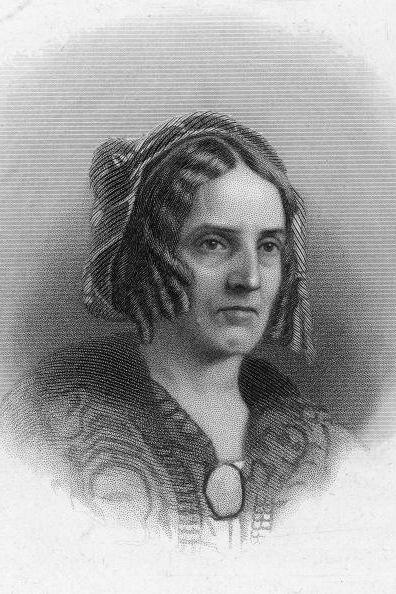
Sarah Childress Polk, 1845
Like most women of the 19th century, Sarah Childress Polk was obsessed with Parisian fashion. She reportedly wore elegant gowns and headdresses imported from France, made from expensive material of velvet, satin, and silk, which were often decorated with imported fringe, ribbons, and lace.

Abigail Powers Fillmore, 1850
Very conscious of her appearance to others, Abigail Powers Fillmore hired someone to do her hair and design special dresses for public occasions. She was the first first lady to have items made on a sewing machine, hence why this dress pictured here is more advanced than previous first lady fashion.
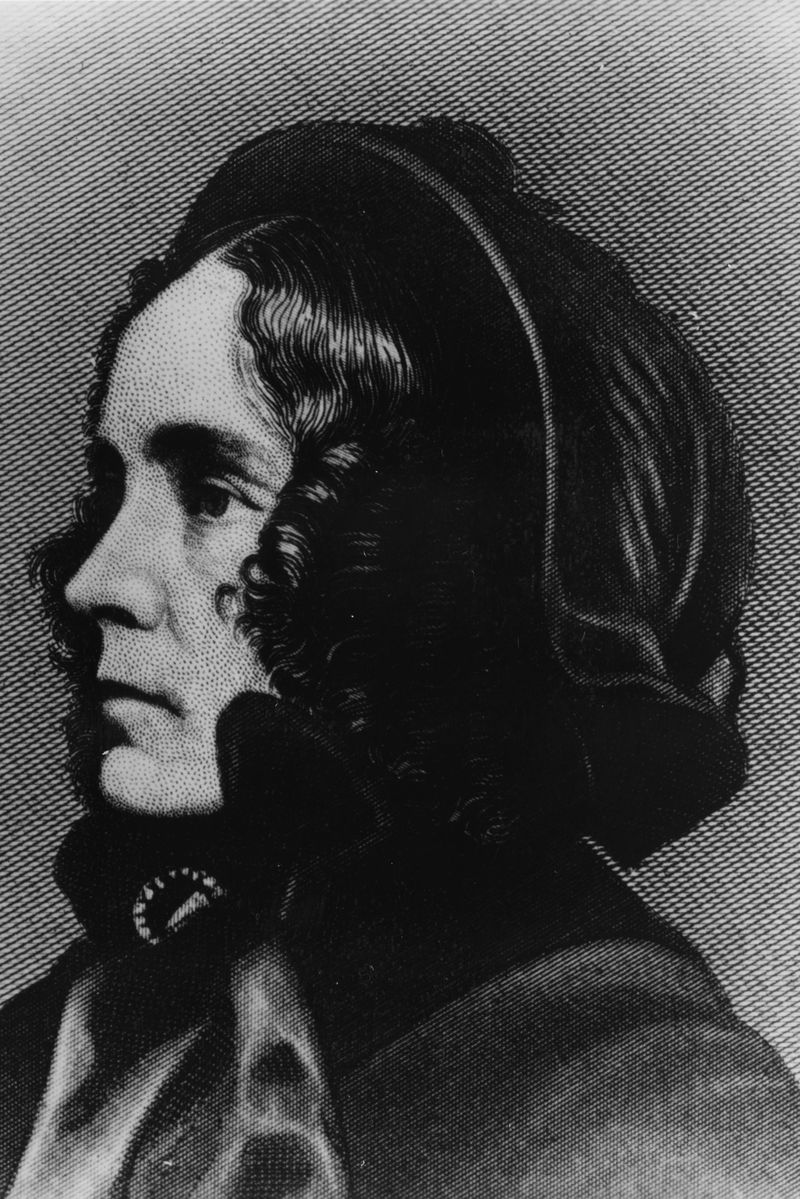
Jane Pierce, Late 19th Century
On the way to her husband's inauguration, Jane Pierce got in a train accident that killed their 11-year-old son, Benjamin. Jane then spent the first two years as first lady in mourning, only wearing black dresses and accessories like the ones seen here.

Harriet Rebecca Lane Johnston, 1860
The niece of James Buchanan is considered to be the Jackie Kennedy of her time. Most notably, she made national headlines for her "very" low-cut European-style dress that she wore to her uncle's inauguration. The dress, pictured here, was a hit among women, and bodices dropped an inch or two almost instantly.

Mary Todd Lincoln, 1861
Like we said in the previous slide, Lane Johnston's dress was a hit. The next first lady, Mary Todd Lincoln, loved the dress style so much she wore something similar to her husband's inauguration. As you can see, she liked her items lavish and is said to have gone $20,000 over the Congressional budget due to her spending habits.

Eliza McCardle Johnson, 1865
Eliza McCardle Johnson, like many other first ladies, didn't want much publicity. Therefore, she usually wore more conservative items like dark dresses with high collars and shawls concealing most of her hair.

Julia Dent Grant, 1876
According to the National Museum of American History, Julia Dent Grant is said to have chosen American-made clothing that were “… becoming to my person and the condition of my purse.” This usually meant rich fabrics with some jewelry made of pearls or diamonds.

Lucy Webb Hayes, 1877
Sticking to the modest clothing trends of the time, Lucy Webb Hayes usually wore modest embroidered dresses in soft colors that covered her throat and arms.

Lucretia Garfield, 1881
While she may have been first lady for only a short period of time, a.k.a. around six months, Lucretia Garfield kept up with the latest fashion. She wore a lavender gown with a high collar to her husband's inaugural ball in 1881, as seen here.

Frances Folsom Cleveland, 1886
Frances Folsom Cleveland was a rule-breaker and caused many controversies when she continually donned dresses that showed off her bare neck, shoulders, and arms. (I mean how gorgeous is this dress though?!) According to Time, the Women’s Christian Temperance Union got so fed up that they issued a petition asking her to stop wearing these dresses. She ignored them.

Caroline Scott Harrison, 1889
Caroline Scott Harrison's fashion choices as first lady deemed her, by The Philadelphia Times, "a sensible exemplar for American women." This was due to her modest wardrobe, featuring gowns with beaded details and floral patterns in neutral colors (almost always) made in America.

Ida Saxton McKinley, 1900
During a trip to Belgium, Ida Saxton McKinley was so shocked by what the workers went through to make the lace she bought, so she did as much as she could to help support them. According to the National First Ladies' Library, this meant a majority of her custom-made dresses featured a significant amount of lace. This inspired many other women to try to replicate the same look.

Edith Kermit Roosevelt, 1902
Edith Kermit Roosevelt liked her privacy and often wore the popular high-waisted dresses with trim skirts and gathered sleeves. She would often wear the same outfit over and over to throw off reporters and make them believe she had a larger closet than she did.

Helen Herron Taft, 1909
The "H" in "Helen Herron Taft" stands for "hats." Okay, maybe not like officially, but the former first lady was known to have a large collection back in the day. She was also the first first lady to donate her inaugural gown for public display.

Ellen Louise Wilson, 1913
It's said that Ellen Louise Wilson spent less than $1,o00 a year on outfits, which is something that would seem totally unheard of today. She often wore plain or patterned high-waisted dresses.

Edith Bolling Wilson, 1920
Woodrow Wilson's second wife mainly wore dark dresses, often with lace, but they were still highly fashionable. Most of her items came from the House of Worth in Paris.

Florence Harding, 1922
Florence Harding often wore heavily-beaded dresses and fur pieces. This dress, pictured here, is so heavy that the dress has to be laid down sideways to avoid ruin when not on display. Crazy, I know!

Grace Goodhue Coolidge, 1927
Compared to her partner, Grace Goodhue Coolidge liked to make a statement and vocalized that through her clothing. She often wore sleek shift dresses in bright colors with outlandish hats. According to the National Museum of American History, her husband would surprise her and pick out her outfits.

Lou Henry Hoover, 1930
During the Great Depression, Lou Henry Hoover kept things simple. She usually wore American-made dresses, emphasizing the importance of cotton clothing to promote the cotton textile industry.

Eleanor Roosevelt, 1939
Large hats were the staple of Eleanor Roosevelt's style. They were often worn with long skirts or dresses that kept up with the conservative aesthetic she wanted to accomplish.
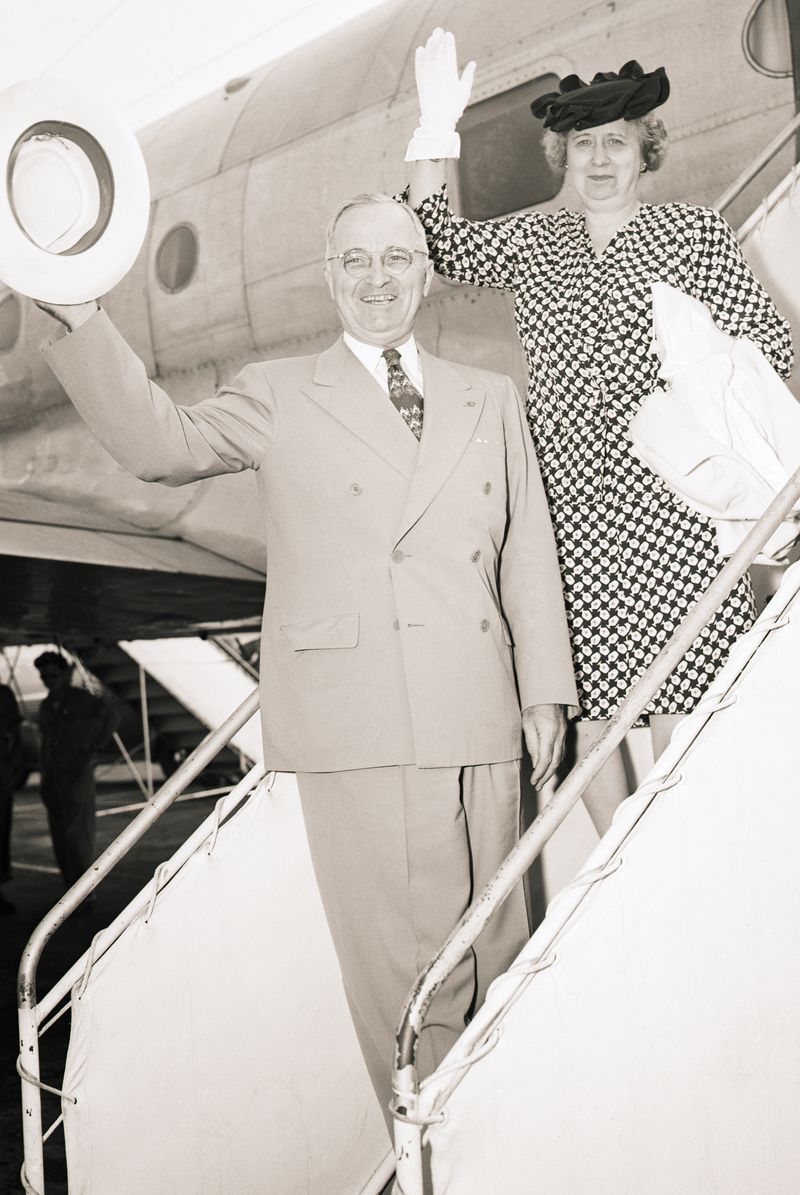
Elizabeth "Bess" Truman, 1946
Not used to being the center of attention, Elizabeth "Bess" Truman liked to wear pieces that allowed her to blend into the background and wouldn't be front-page news. This meant her wardrobe consisted of patterned shirtwaist dresses with tea-length skirts, as pictured here.
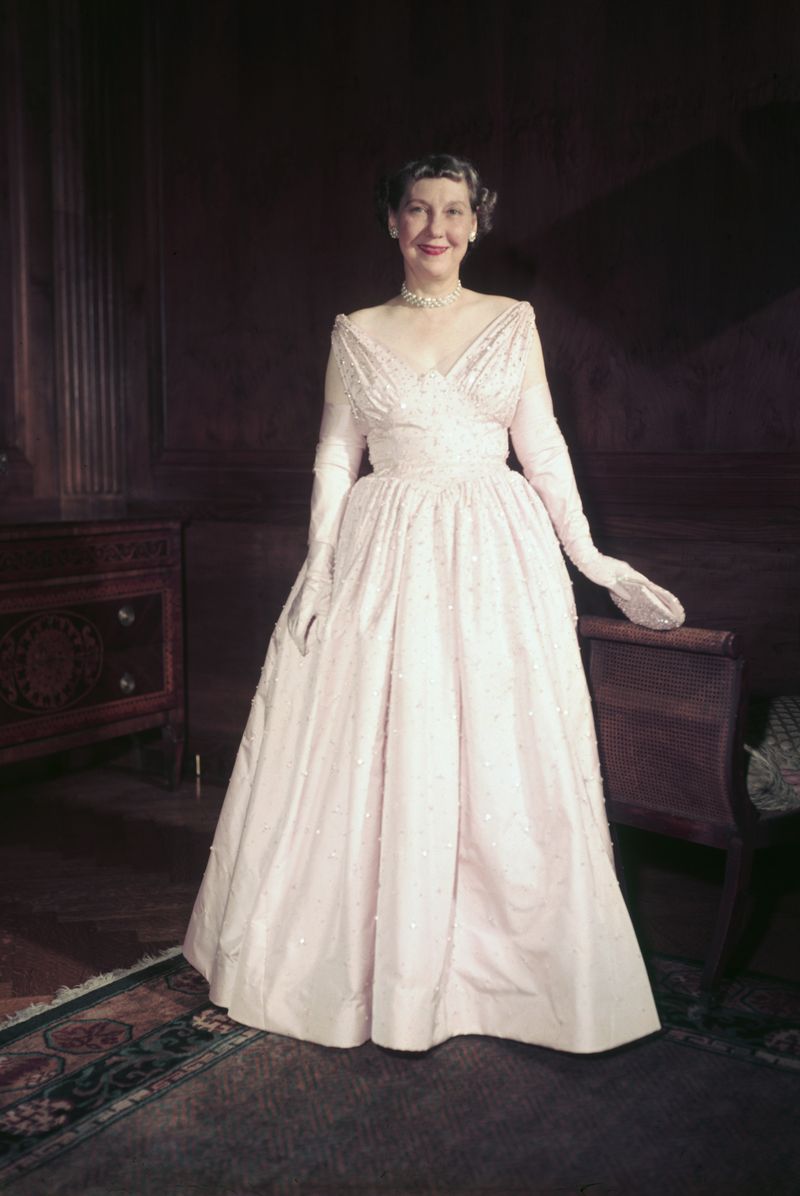
Mamie Doud Eisenhower, 1953
Mamie Doud Eisenhower wore this bubblegum pink shade so much during her time as first lady. It eventually became known as "Mamie pink" and was donned by most women in the '50s and early '60s.

Jacqueline Kennedy Onassis, 1963
During her time as first lady and for years after, Jackie O. designed most of her clothes. She's probably the most memorable fashionable first lady in history, and it's easy to see why.

Claudia 'Lady Bird" Johnson, 1965
Claudia Johnson wasn't necessarily into the glitz and glamour like other first ladies. Instead, she's remembered for her more casual looks, like this mountain-chic get-up she wore on a visit to Jackson Lake in Wyoming.

Patricia Nixon, 1969
Patricia Nixon was considered a fashion trailblazer even before her husband was sworn in as president. At her husband’s 1969 inauguration, she wore a fur hat, rather than a cloth one, and a bright pink coat trimmed in fur.

Betty Ford, 1976
While she may have only been the first lady for little over two years, the former Martha Graham dancer and department store model was known for her colorful scarves and high-neck collars seen here.

Rosalynn Carter, 1978
Rosalynn Carter reportedly didn't care much for flashy clothing items, preferring designs with raised necklines and long sleeves. According to the Washington Post, she even brought a sewing machine to the White House to bring life to old vintage items.
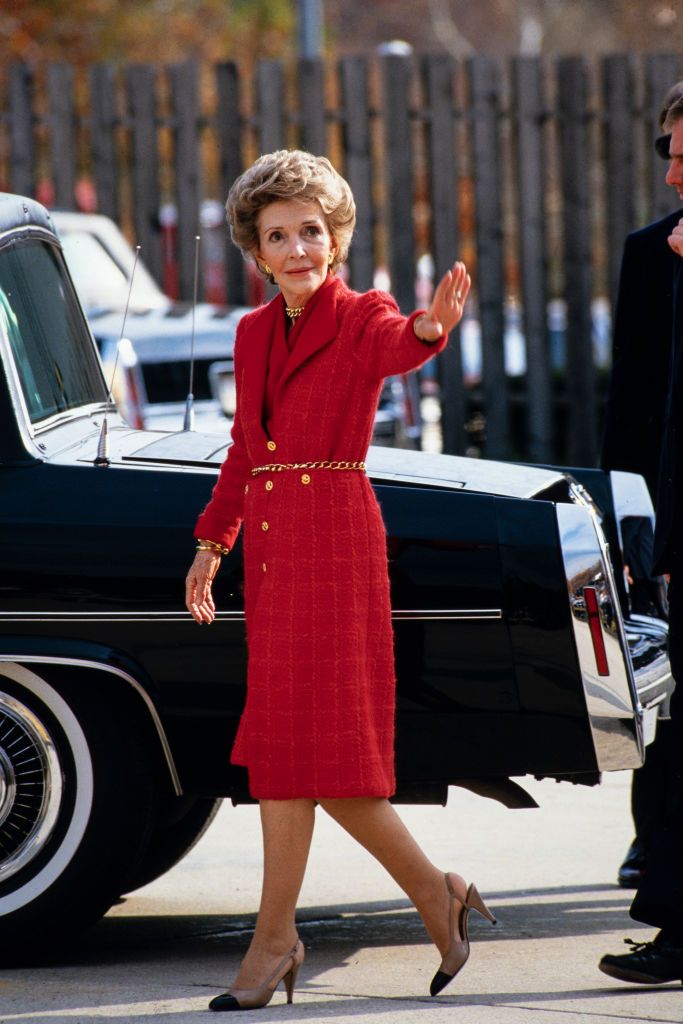
Nancy Davis Reagan, 1985
The former film actress knew how to dress, but most importantly: accessorize. I mean, the gold chain belt? Come on! Nancy Reagan reportedly wore this crimson red color so much that it eventually became known as “Reagan red" among the press.

Barbara Bush, 1991
Even off-duty, Barbara Bush was never seen without her iconic red lipstick or a shade a blue. She always strived to wear red, white, and blue during her time as a former first lady. This outfit definitely checks all of those boxes.

Hillary Clinton, 1997
Here at Marie Claire, we know how influential Hillary is when it comes to first lady fashion. I mean, the pantsuit was practically invented by her, but for history's sake, we're highlighting this iconic gem: a deep blue turtleneck with a matching plaid jacket.

Laura Bush, 2005
Laura Bush was known overall for her conservative fashion when her husband, George W. Bush, was in office. However, according to the National First Ladies' Library, she liked to stand out in colorful bright pieces when it came to evening gowns.

Michelle Obama, 2013
Most first ladies before Michelle Obama would never have dared to wear a halter dress, which is why this ruby-red chiffon and velvet halter-neck gown by Jason Wu that she wore to Barack Obama's second inaugural ball is next-level iconic.

Melania Trump, 2018
The former model has chosen some interesting fashion choices over the past four years, but this creamy outfit that she wore to the Giza Pyramids in Egypt is the most surprising. From the straw brimmed hat to the men's tie, it shows how far first lady fashion has truly come.
Get exclusive access to fashion and beauty trends, hot-off-the-press celebrity news, and more.

Bianca Rodriguez is the Audience Development Manager at Future, covering fashion, beauty, and more for Marie Claire, Who What Wear US and Who What Wear UK. In addition to spearheading SEO content across brands—whether writing about wardrobe must-haves or strategizing how to make eye-catching content—she is also an avid reader with a deep love and knowledge for books of all genres. More often than not, you can find her lounging with a good book on the weekend.